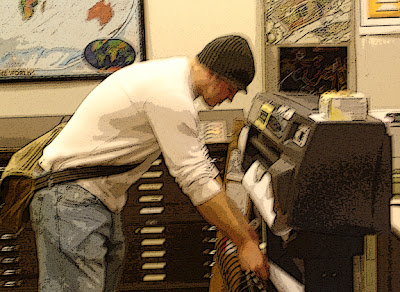 Color Printing at Ball State University Libraries
Color Printing at Ball State University LibrariesThe Geospatial Resources & Map Collection has a large-format plotter available for anyone with a Ball State University account. The paper is 36 inches wide and prints copies as long as 108 inches. The charge for posters is $8 for the first 36 inches, $10 for prints from 37 to 72 inches, and $12 for prints from 73 to 108 inches. The charges are sent through the Bursar’s Office billing system.
Smaller color copies up to 11 by 17 inches can also be made at Bracken Library for 25 cents per page. From any computer in University Libraries, simply open the file menu and select “Print.” Use the drop-down box to select the color printer on 1 East or 1 West. Click either “OK’ or “Print” depending on the program. Type a name for the print job or select the option to use the file name and click “OK.” Pre-pay 25 cents per page at the selected printer, either with a copy card or with cash. Touch the “Mailbox” tab on the printer display. Touch the first box “BSU,” then select your print job from the list. Touch the “Print” button and “Start Print.”
Wireless laptop printing is also available in Bracken Library. To access this service, go to http://www.bsu.edu/libraries/laptopprint. Print jobs may be sent from the laptop to the Periodical/Reserve area of Bracken Library, the Architecture Library, Educational Resources Collections in Bracken Library, the Science-Health Science Library, and the first floor lobby of Bracken Library.

















































